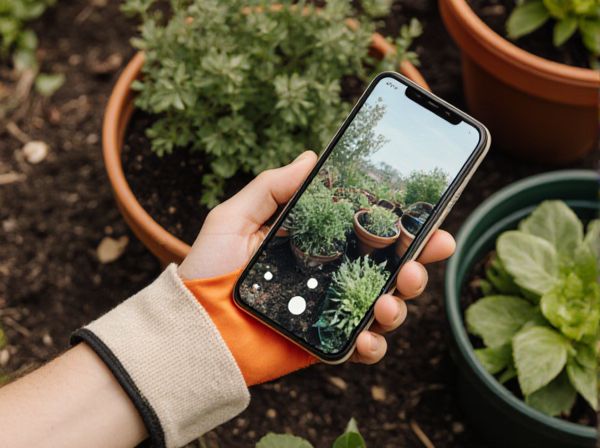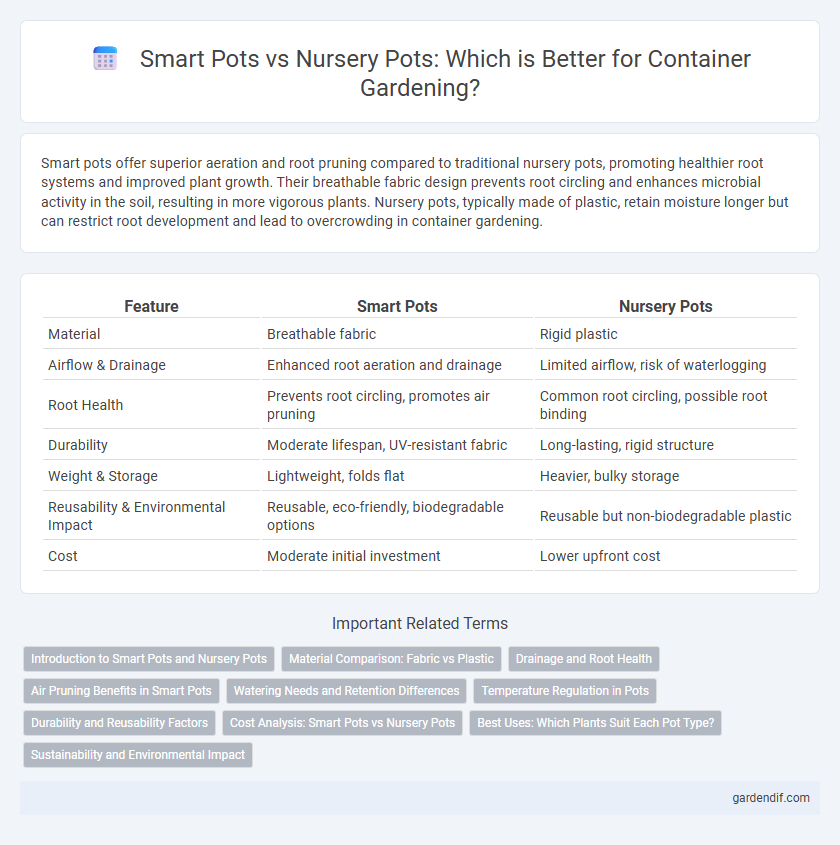
Smart pots vs nursery pots Illustration
Smart pots offer superior aeration and root pruning compared to traditional nursery pots, promoting healthier root systems and improved plant growth. Their breathable fabric design prevents root circling and enhances microbial activity in the soil, resulting in more vigorous plants. Nursery pots, typically made of plastic, retain moisture longer but can restrict root development and lead to overcrowding in container gardening.
Table of Comparison
| Feature | Smart Pots | Nursery Pots |
|---|---|---|
| Material | Breathable fabric | Rigid plastic |
| Airflow & Drainage | Enhanced root aeration and drainage | Limited airflow, risk of waterlogging |
| Root Health | Prevents root circling, promotes air pruning | Common root circling, possible root binding |
| Durability | Moderate lifespan, UV-resistant fabric | Long-lasting, rigid structure |
| Weight & Storage | Lightweight, folds flat | Heavier, bulky storage |
| Reusability & Environmental Impact | Reusable, eco-friendly, biodegradable options | Reusable but non-biodegradable plastic |
| Cost | Moderate initial investment | Lower upfront cost |
Introduction to Smart Pots and Nursery Pots
Smart pots are breathable fabric containers designed to enhance root aeration and promote healthier plant growth by preventing root circling and improving drainage. Nursery pots, typically made from rigid plastic, provide a durable and reusable solution for seedling propagation and plant development but often restrict airflow to roots. The choice between smart pots and nursery pots depends on factors like plant type, watering needs, and root health priorities.
Material Comparison: Fabric vs Plastic
Smart pots made from breathable fabric enhance root aeration and drainage, promoting healthier plant growth by preventing root circling and overwatering issues common in plastic nursery pots. Fabric materials provide superior moisture regulation and temperature control, reducing stress on plants compared to traditional plastic containers that can retain heat and limit airflow. While plastic pots are lightweight and durable, their non-porous nature often leads to waterlogging and insufficient oxygen supply, making fabric smart pots a more efficient choice for sustainable gardening.
Drainage and Root Health
Smart pots offer superior drainage through their breathable fabric design, which allows excess water to escape easily, preventing waterlogging and promoting oxygen flow to the roots. In contrast, traditional nursery pots often retain excess water, increasing the risk of root rot and poor aeration. Enhanced drainage in smart pots encourages healthier root systems by reducing stress from overwatering and improving nutrient uptake.
Air Pruning Benefits in Smart Pots
Smart pots feature a breathable fabric design that promotes air pruning, which naturally stops root circling by exposing root tips to air, causing them to dry and stimulate the growth of new lateral roots. This process enhances root structure, leading to healthier plants with improved nutrient and water uptake compared to traditional nursery pots. The increased oxygen availability in smart pots also supports robust microbial activity and root respiration, ensuring optimal plant development.
Watering Needs and Retention Differences
Smart pots offer superior water retention compared to traditional nursery pots due to their breathable fabric material, which allows for better aeration and reduces waterlogging. Nursery pots, typically made from plastic, retain water longer but can cause root rot due to poor drainage and limited airflow. This difference in watering needs makes smart pots ideal for plants requiring consistent moisture without overwatering, while nursery pots suit drought-tolerant species that prefer less frequent watering.
Temperature Regulation in Pots
Smart pots offer superior temperature regulation compared to traditional nursery pots due to their breathable fabric material, which allows for better air circulation and heat dissipation. This enhanced airflow prevents root overheating and promotes a more stable root zone temperature, crucial for optimal plant growth. In contrast, nursery pots, usually made of plastic, tend to retain heat, risking root stress and reduced plant health during hot conditions.
Durability and Reusability Factors
Smart pots offer enhanced durability due to their sturdy, breathable fabric that resists tearing and UV damage, supporting multiple growing cycles without degradation. Nursery pots, typically made from thin plastic, tend to crack or become brittle after repeated use, limiting their reusability. The breathable design of smart pots also prevents root circling and promotes healthier plant growth, extending the lifespan of both the container and the plants.
Cost Analysis: Smart Pots vs Nursery Pots
Smart pots typically cost more upfront than traditional nursery pots due to their advanced breathable fabric design that promotes root health and prevents overwatering. However, smart pots offer long-term savings by improving plant growth rates and reducing the need for repotting and pest treatments. Nursery pots, while cheaper initially, may increase costs over time because of limited durability and higher risks of root circling and water retention issues.
Best Uses: Which Plants Suit Each Pot Type?
Smart pots, made from breathable fabric, are ideal for plants requiring excellent aeration and root health, such as tomatoes, herbs, and root vegetables, promoting vigorous growth and preventing root circling. Nursery pots, typically plastic, suit seedlings and transplanting, offering durability and moisture retention, making them perfect for starting a wide range of plants before moving to larger containers. Choosing the right pot depends on plant type and growth stage, with smart pots favoring mature, aeration-sensitive plants and nursery pots supporting early development.
Sustainability and Environmental Impact
Smart pots, made from breathable, recycled fabric, improve root aeration and reduce transplant shock while significantly lowering plastic waste compared to traditional nursery pots. Nursery pots, typically crafted from non-biodegradable plastic, contribute to landfill pollution and require energy-intensive recycling processes. Choosing smart pots supports sustainable gardening practices by minimizing environmental impact and promoting soil health through enhanced water retention and root oxygenation.
Smart pots vs nursery pots Infographic

 gardendif.com
gardendif.com